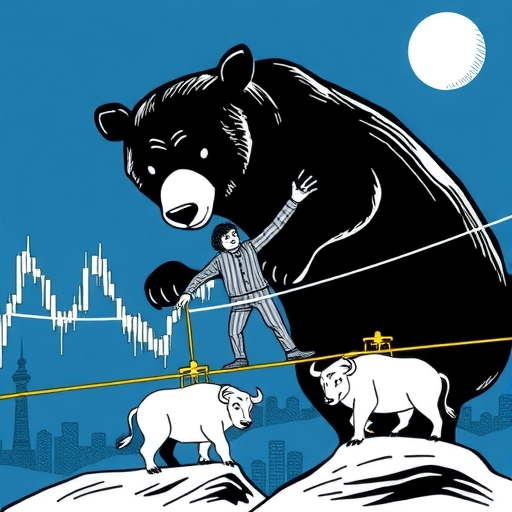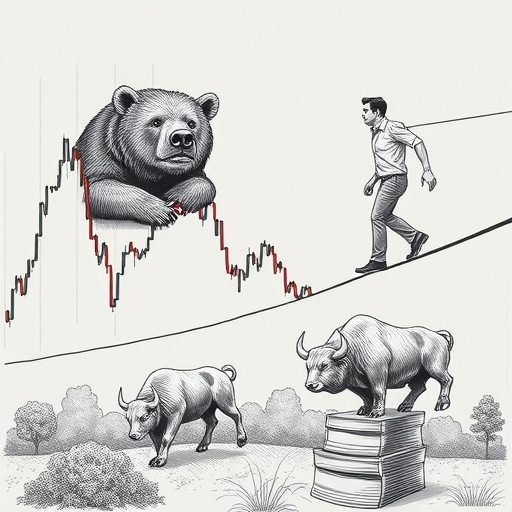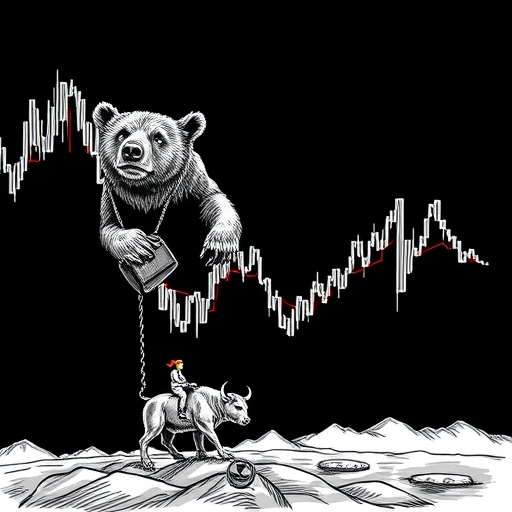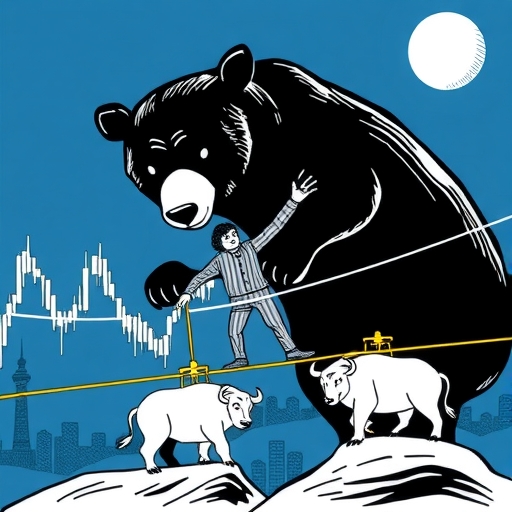Unpacking the Bear Market: Navigating Volatility Fueled by Tariffs and Trade Tensions
Recent global events, particularly the escalating trade tensions driven by the implementation of tariffs, have dramatically amplified stock market volatility. This period of heightened uncertainty has placed the concept of a bear market firmly back in the spotlight, prompting investors like you to seek clarity. Understanding what a bear market truly entails, its historical context, and how such downturns can impact economies and investment strategies is absolutely crucial right now.
- Market downturns are often marked by significant declines and increased uncertainty.
- Historical bear markets can provide insights into potential future market behavior.
- Investment strategies differ greatly between bull and bear markets.
Think of the market as a vast, complex ecosystem, constantly reacting to new information, economic shifts, and, yes, political decisions. When things are calm and growing, we often talk about a “bull market,” full of optimism and upward momentum. But what happens when that momentum stalls, reverses, and fear takes hold? That’s when the ‘bear’ emerges from hibernation, and understanding its behavior becomes paramount.

Defining the Bear Market: More Than Just a Bad Day
So, what exactly is a bear market? On Wall Street, the widely accepted definition is a 20% or greater decline in a major stock market index from a recent high. This isn’t just a temporary dip; it’s typically a decline that is sustained over a period, reflecting broad pessimism and selling pressure across the market.
We often use major indices like the S&P 500, the Dow Jones Industrial Average, and the Nasdaq Composite as the barometers for identifying these market phases. When one or more of these key indices drops by 20% or more from its peak, analysts and investors begin to classify the period as a bear market. It’s a clear, albeit somewhat arbitrary, line drawn in the sand to signal a significant shift in market sentiment and trend.
| Index | Threshold (%) |
|---|---|
| S&P 500 | 20% |
| Dow Jones | 20% |
| Nasdaq Composite | 20% |
Is it just about the percentage drop? Not entirely. While the 20% threshold is the common trigger, the ‘sustained’ aspect is also important. A brief, sharp drop followed by an immediate, strong recovery might be called a “correction,” but a true bear market implies a more prolonged period where selling dominates buying, and investor confidence is significantly eroded.
Bulls, Bears, and Market Psychology: Understanding the Analogy
Why ‘bull’ and ‘bear’? The origins of this popular Wall Street analogy are a bit debated, but the most common explanation relates to how the animals attack. A bull charges forward, thrusting its horns upward, symbolizing rising prices. A bear, on the other hand, is said to swipe downwards with its claws, representing falling prices.
This simple metaphor captures the essence of market direction and, more importantly, market psychology. Bull markets are characterized by optimism, confidence, and buying momentum. Investors are eager to get in, believing prices will continue to rise.
Bear markets are the opposite. They are fueled by pessimism, fear, and a rush to sell. As prices fall, fear often begets more fear, leading to panic selling and accelerating declines. This psychological dynamic is a powerful force, capable of pushing markets lower even when underlying economic fundamentals might seem stable. Understanding this inherent human element – the tendency towards greed in a bull market and fear in a bear market – is vital for any investor.

The Tariff Storm: President Trump’s Policy and Global Trade War
In recent times, a major catalyst for increased market volatility and the potential for a bear market has been the escalation of global trade tensions, particularly those initiated by the Trump administration’s tariff policies. These policies represented a significant shift from decades of increasing global trade liberalization.
President Trump’s approach involved implementing tariffs – essentially taxes on imported goods – with various goals, including reducing trade deficits, protecting domestic industries, and pressuring trading partners to change their practices. A prominent example was the imposition of a baseline 10% tax on many imported goods, which later escalated into a broader “tariff blitz.”
A central focus of these tariffs was China. The administration imposed significant tariffs on a wide range of Chinese goods, citing issues related to trade imbalances, intellectual property theft, and forced technology transfer. The intention was to leverage economic pressure to force concessions from Beijing.
However, as we’ve seen repeatedly throughout history, such actions rarely occur in a vacuum. China responded to the US tariffs with retaliatory tariffs of their own, targeting American goods. This tit-for-tat exchange created a full-blown trade war between the two largest economies in the world. This conflict didn’t just impact the US and China; it sent ripples of uncertainty and disruption across global supply chains and financial markets, becoming a primary driver of fear on Wall Street and beyond.
Economic Fallout: How Tariffs Translate to Real-World Costs and Uncertainty
The impact of tariffs extends far beyond the fluctuating numbers on a stock ticker. Economically, tariffs function like a tax. While levied on importers, these costs are often passed down the line, potentially affecting businesses and consumers.
For businesses that rely on imported raw materials or components, tariffs increase their operating costs. These costs might be absorbed, leading to reduced profit margins, or they might be passed on to consumers in the form of higher prices. This potential for rising prices can contribute to inflation, eroding purchasing power.
Furthermore, the uncertainty created by an unpredictable trade environment is economically damaging. Businesses thrive on predictability. When faced with constantly shifting tariff rates or the threat of new tariffs, companies find it incredibly difficult to make long-term plans. Should they build a new factory? Where should they source their materials? Should they hire more workers or delay investment?
| Challenge | Effect |
|---|---|
| Increased operating costs | Reduced profit margins |
| Higher consumer prices | Erosion of purchasing power |
| Unpredictable trade environment | Difficult long-term planning |
This uncertainty complicates crucial business decisions regarding everything from supply chain locations to supplier relationships and capital expenditures. When businesses hesitate to invest or expand due to external unpredictability, it can put a significant brake on economic growth. Reports and surveys during periods of high trade tension often showed executives holding back on major investment projects, waiting for clarity. This slowdown in business activity contributes to the broader economic pain that can accompany a trade war, further weighing on market sentiment and increasing the probability of a market downturn.
Market’s Immediate Reaction: Volatility, Sell-offs, and Specific Sector Impacts
The immediate aftermath of significant tariff announcements and retaliatory measures has been characterized by extreme market volatility. We’ve seen days where major indices like the S&P 500 experienced massive point swings, sometimes gaining hundreds of points one day only to lose them, and more, the next.
This level of day-to-day turbulence is not typical. Historically, such high volatility has been comparable only to periods of major economic crises, such as the 1987 market crash (often referred to as Black Monday), the depths of the 2008 financial crisis, or the abrupt downturn triggered by the initial phase of the pandemic in early 2020.

The fear and uncertainty generated by the trade war led to significant sell-offs across various sectors. Companies with extensive international supply chains or significant exposure to the Chinese market were particularly vulnerable. For example, many large technology companies (often referred to collectively, or even historically as the “Magnificent Seven” or simply “Big Tech“), with their global operations and reliance on manufacturing in Asia, felt the pressure. Even seemingly resilient stocks like Apple and Nvidia could face headwinds from tariffs or supply chain disruptions.
However, not all sectors reacted uniformly. In some instances, specific policy news unrelated to tariffs could cause certain sectors to rally, even amidst broader market declines. We saw examples where positive news regarding government reimbursement rates for health insurance (like changes affecting Medicare Advantage rates) could send stocks in companies like Humana, CVS Health, or UnitedHealth Group higher, showing how specific industry fundamentals can sometimes diverge from the overall market trend.
This divergence highlights that even in a volatile, downward-trending market, opportunities and relative strength can exist in certain areas, often tied to sector-specific news or defensive characteristics.
Understanding Circuit Breakers: Mechanisms to Pause the Panic
When market declines become exceptionally sharp and rapid, there are mechanisms in place designed to literally pause trading and allow investors a moment to breathe and reassess the situation. These are known as circuit breakers.
Established by the SEC (Securities and Exchange Commission), circuit breakers are rules that automatically halt trading across major US stock exchanges if the S&P 500 index falls by specific percentage thresholds from its closing price on the previous day. These thresholds are set at 7%, 13%, and 20%.
| Drop % | Action |
|---|---|
| 7% | 15-minute trading halt |
| 13% | 15-minute trading halt (if before 3:25 PM) |
| 20% | Trading halt for the remainder of the day |
For example, a 7% drop before 3:25 p.m. ET would trigger a 15-minute trading halt across the entire market. A 13% drop, if it occurs before 3:25 p.m., would also lead to a 15-minute halt. However, if the 13% drop happens at or after 3:25 p.m., trading continues unless the 20% threshold is hit. A 20% drop at any time during the trading day triggers a halt for the remainder of the day.
These measures were put in place after significant market crashes, most notably the 1987 crash, where the speed of the decline was exacerbated by rapid, unchecked selling. The idea behind circuit breakers is to prevent cascading panic, give market participants time to process information, and potentially restore some order to trading. We saw circuit breakers triggered multiple times during the extreme volatility of the March 2020 bear market, and similar mechanisms exist and have been recently triggered in other global markets, such as in Japan with its Nikkei 225 futures.
A Journey Through History: Lessons from Past Bear Markets
Looking back at the history of the stock market provides invaluable context for understanding current events. Bear markets are not unprecedented; they are a recurring, albeit uncomfortable, part of the market cycle. Examining historical data can help us understand what to potentially expect in terms of duration, depth, and recovery.
- The most recent S&P 500 bear market ran from January 3 to October 12, 2022, seeing a notable decline before a subsequent rally.
- The 2020 bear market was historically significant for its speed. Fueled by the sudden onset of the pandemic, the S&P 500 plunged by about 34% in just over one month (roughly from mid-February to mid-March 2020). This was the shortest bear market on record.
- The deepest bear market since 1945 was the one associated with the 2007-2009 financial crisis. During this period, the S&P 500 fell approximately 57% from its peak.
- The longest bear market since 1942 stretched for 61 months and saw a decline of around 60%, although market structure and economic conditions were vastly different then.
Interestingly, historical data suggests a potential correlation between the speed at which a market enters a bear market and its potential depth. Markets that enter bear territory very quickly have, on average, experienced shallower losses (around 28%) compared to the overall average (33%). This doesn’t guarantee future outcomes, but it’s an interesting pattern to observe.
Navigating the Downturn: Strategies for Investors During a Bear Market
Market downturns can be unnerving, especially for new investors. Seeing your portfolio value decrease can trigger fear and the urge to sell everything to stop the losses. However, financial history and expert advice strongly suggest that for most long-term investors, this is often the wrong course of action.
One of the most critical pieces of advice during a bear market is to maintain a long-term perspective. Investing in the stock market is generally most suitable for money you won’t need for several years, perhaps five or more. Stock markets are cyclical; they go up and down, but over long periods, they have historically trended upwards, reflecting economic growth and innovation.
- Keep emotions in check; panic selling can lock in losses.
- Consider dollar-cost averaging to manage volatility.
- Assess the time horizon for your investments before making decisions.
Panic selling during a sharp decline can be particularly detrimental. When you sell during a market bottom or close to it, you essentially lock in your losses. Furthermore, you risk missing the subsequent recovery. Some of the strongest days and periods of market gains historically occur during or immediately following bear markets. Think about the powerful rallies that began in March 2009 (after the 2007-2009 bear market low) or the sharp rebound that started in late March 2020 (after the pandemic low).
Investors who sold out of fear missed these significant opportunities for their portfolios to recover and grow. A disciplined approach, perhaps involving dollar-cost averaging (investing a fixed amount regularly, regardless of market fluctuations, so you buy more shares when prices are low), can be a more effective strategy during volatile times.
Consider your investment goals and time horizon. Is this money you need for a down payment next year, or is it for retirement in two decades? The answer should heavily influence your strategy during a bear market. Money needed in the short term should generally not be exposed to the volatility of the stock market.
Beyond Equities: Bond Markets and Other Assets During Turmoil
While much of the focus during market downturns is on stocks, other asset classes also react to economic uncertainty and shifts in sentiment. Bond markets, particularly government bonds like US Treasuries, often behave differently than stocks during periods of stress.
When investors become fearful and sell stocks (a “risk-off” move), they often seek safety in assets perceived as less risky. US Treasury bonds are typically considered a safe haven. Increased demand for Treasuries drives up their prices, which in turn pushes their yields downwards. Monitoring Treasury yields, such as the 10-year yield or 30-year yield, can provide insights into investor sentiment and expectations about future economic growth and interest rates.
In a volatile environment fueled by trade wars and economic uncertainty, we’ve seen significant swings in bond yields as well, reflecting the market’s struggle to price in conflicting signals about inflation (potentially higher due to tariffs) and slowing growth (due to uncertainty and delayed investment). The dynamics of bond yields can be complex, influenced by Federal Reserve policy, inflation expectations, and global demand for safe assets.
Beyond traditional stocks and bonds, investors might consider other asset classes or trading instruments, especially if looking to diversify or potentially capitalize on different market movements. For instance, some traders explore forex trading (foreign exchange) or trading various instruments via CFDs (Contracts for Difference). These markets have their own drivers, distinct from or only indirectly related to the specific trade war issues affecting equity supply chains.
If you’re considering diversifying your exposure or exploring markets like foreign exchange or other CFD products, choosing the right platform is a critical first step. Finding a platform that is well-regulated and offers a wide range of instruments could be beneficial for implementing diverse strategies.
The Recovery Phase: How Bear Markets End and What to Look For
Just as bear markets eventually begin, they also eventually end. Defining the exact moment a bear market concludes can sometimes be tricky in real-time, but typically, a bear market is considered over when the market, as measured by the benchmark index (like the S&P 500), rallies by 20% from its bear market low. This gain should ideally be sustained over a period, indicating a shift in momentum and sentiment.
The 20% rally threshold is, again, a standard definition used on Wall Street. It signals that the selling pressure has subsided and buying confidence has returned, leading to a significant upward move from the previous bottom. However, like the start of a bear market, the recovery isn’t always smooth or perfectly aligned with this definition.
As we saw in 2020, the recovery was incredibly swift. The S&P 500 hit its low in late March and recovered its 20% mark remarkably quickly, confirming the end of the shortest bear market ever. Other recoveries, like the one after the 2007-2009 financial crisis, were more gradual initially, though still significant over time.
It’s important to recognize that the lowest point of a bear market, the “trough,” is only clearly identifiable in hindsight. Nobody rings a bell at the bottom. Trying to time the market perfectly by selling at the top and buying at the absolute bottom is exceedingly difficult, if not impossible, for most investors.
Focusing instead on whether the market has made a sustained move upward, recovering a significant portion of its losses, is a more practical approach to identifying the end of the bear phase and the potential start of a new bull run.
When considering different trading platforms for various financial instruments, including potentially forex or CFDs which might interest traders during volatile times, assessing their features becomes important. Platforms like Moneta Markets, offering support for MT4, MT5, and Pro Trader, alongside features like high-speed execution and competitive spreads, demonstrate the kind of technical capabilities traders often look for.
The Wisdom of Patience: Maintaining Perspective Amidst Uncertainty
In a world filled with 24/7 news cycles and constant market updates, it’s easy to get caught up in the short-term noise. The fear generated by tariffs, trade wars, and the threat of a bear market can feel overwhelming. However, cultivating patience and maintaining a long-term perspective are perhaps the most valuable tools an investor can possess during such periods.
Markets are cyclical. Downturns, while painful, are a normal part of the investing landscape, just as bull markets are. Historically, every bear market has eventually been followed by a recovery and a new bull market that reached higher highs than the previous ones. This historical pattern is the foundation of long-term investing success.
Focus on what you can control: your investment plan, your asset allocation, your savings rate, and your emotional reaction to market fluctuations. Instead of panicking about daily price swings, focus on the fundamentals. Are the companies you’re invested in still sound businesses over the long term? Does your overall portfolio alignment still match your financial goals and risk tolerance?
Understanding the economic forces at play, like the impact of tariffs and trade tensions, provides context, but it shouldn’t necessarily dictate impulsive decisions that deviate from a well-thought-out plan. Knowledge is power, but it’s the application of that knowledge with discipline and patience that ultimately helps investors navigate uncertain times and position themselves for future growth when the inevitable recovery takes hold.
bear market exampleFAQ
Q:What is a bear market?
A:A bear market is typically defined as a decline of 20% or more in a major stock market index from its recent high.
Q:What are the psychological factors affecting bear markets?
A:Pessimism and fear drive investors to sell, leading to panic selling that exacerbates market downturns.
Q:How can investors navigate a bear market effectively?
A:Investors should maintain a long-term perspective, avoid panic selling, and consider strategies like dollar-cost averaging.

留言